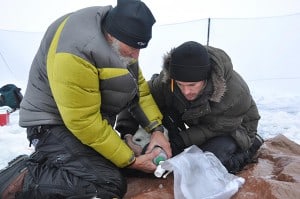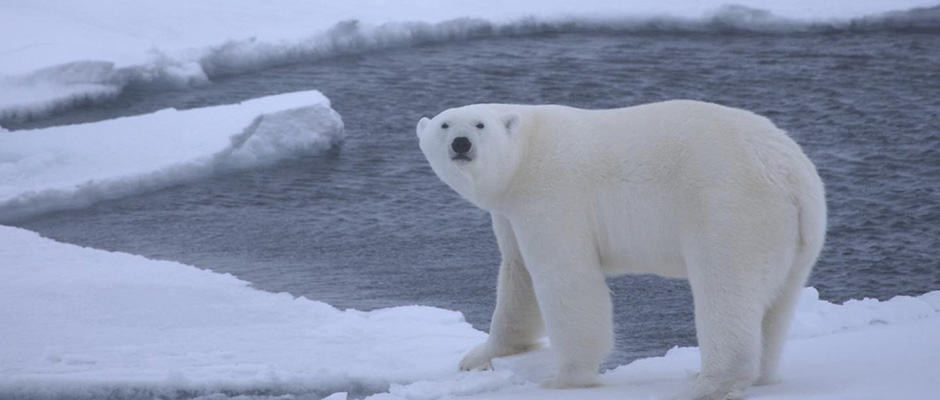Share this article
Polar Bears Lack Ability to Survive Long Summers
As sea ice continues to melt, polar bears don’t have the resources to survive extended periods of famine, according to a new study tracking the way the animals move and manage body temperatures.
“A lot of things are changing and that’s why it’s hard to forecast into the future,” said Merav Ben-David, wildlife ecologist at the University of Wyoming, member of The Wildlife Society and coauthor of a new study published last week in Science. But one thing is now sure — the bears don’t have an innate ability to live through longer summers without eating.

A young polar bear on pack ice over deep waters in the Arctic Ocean, October 2009. A new study discounts an old theory about polar bears using “walking hibernation” to get them through summer months without food.
Image Credit: Shawn Harper
“There are limits to how long they can fast,”
Ben-David said. The massive animals tend to manage their yearly diet by periods of intense feast or famine, eating their fill of fat-laden baby seals during the spring when the pups are abundant on sea ice. But once the temperature warms up in the summer and the seals learn how to swim, they evade polar bears (Ursus maritimus) more easily and many bears go hungry for months.
A few decades ago some researchers theorized that the bears get through these lean months through a physical mechanism that amounts to a kind of “walking hibernation” that allows them to conserve the energy they stored from the spring seal hunt.
“We expected a steep and fast decline from 38 to 35 (degrees Celsius), which is typical in hibernating bears,” Ben-David said — a drop in temperature typical of bears when they actually go into hibernation during the winter. But, “we did not find evidence of ‘walking hibernation’ and the associated energy savings that would come with it.”
To conduct the study, the team first caught bears from the Southern Beaufort Sea population in the spring. Between 2008 and 2010, they fitted 26 bears with GPS collars mounted with activity sensors that measured acceleration in a similar way to the walking devices people use to track calorie burning during diets, and temperature loggers. They also surgically implanted temperature loggers into the bears. They then caught the bears again on the shore in August, then once more in October on the ice or on the shore.
The research wasn’t always easy, and the difficulties the team faced in some ways reflect those of the bears themselves. Storms in the area are changing, and while bears usually dig into the snow and ice for shelter, the ice breakup brings more devastating effects. “You have big waves that carry with them big chunks of sea ice,” Ben-David said. “It’s very unpleasant to say the least.”
In fact, at one point some of the ice chunks got washed onto the icebreaker that the researchers used to recapture the bears. The collared bear they were trying to get to was on the ice, but the sea was too violent to approach in several occasions. As a results, they only managed to recapture around half of the 26 animals. In another instance, the weather was so bad that a bear they were following with two cubs emerged with only one after the storm was over.
“Conditions in the Arctic are different today than they were a while back,” Ben-David said.
Bears Use Built-in Wetsuit Technology to Swim
Polar bears have an amazing ability to swim long distances — the team tracked one female bear swimming for nine days straight, at which point she rested for 12 hours then swam for another two. But what surprised the researchers was that sensors showed the bears use a kind of body temperature control similar to penguins during extended swimming periods. The sensors showed the bears’ body temperature dropped to levels as low as 22 degrees Celsius(approximately 70 degrees Fahrenheit) while swimming. “They were reducing blood flow to the periphery of the core, creating an insulating shell that reduces the gradient between the skin and the sea water,” Ben-David said. “It’s the same principle [as wetsuits] but they do it with their own tissues.”
Overall, she said that more research will be needed to determine how long the bears are able to fast, though this will be variable since different populations live under different habitat and food conditions. But this recent study at least shows that “they can’t fast forever during the summer” — a troubling finding as the warming climate pushes the season longer and longer.
Check out a video of some of the research here.
Header Image:
A young polar bear on pack ice over deep waters in the Arctic Ocean, October 2009. A new study discounts an old theory about polar bears using “walking hibernation” to get them through summer months without food.
Image Credit: Shawn Harpe








